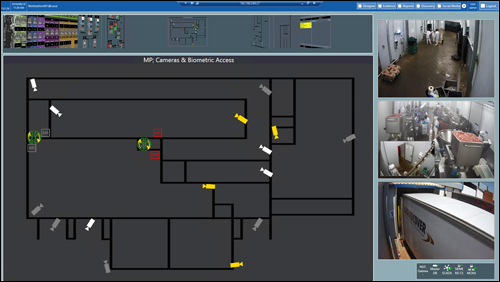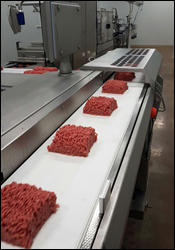Aug 24, 2016Cavalier Group, a vertically integrated provider of red meat to South African retailers, operates cattle and lamb livestock farms, feedlots, livestock trading houses, slaughterhouses and meat packing plants across the country. It had relied heavily on various sensors to manage its operations—such as thermistors that are used to ensure its chillers are operating optimally—and its security systems, such as access control and CCTV cameras. But because those sensor and security networks were in silos with separate interfaces, they were not always easy to use. Rather than juggling those siloed systems, managers wanted a single platform through which workers could receive and respond to alerts from both the company's operational and security systems.
It turned to IoT.nxt, a Pretoria-based startup, to integrate these disparate systems through a common interface that would enable Cavalier Group employees to receive and respond to alerts through either desktop software or a mobile phone. The technology has been deployed at a multi-use facility that Cavalier Group operates in Cullinan, South Africa, where it operates feedlots as well as abattoirs for cattle and lamb, and where it is currently relocating its meatpacking operations, from a facility in Johannesburg.
Nico Steyn, CEO of IoT.nxt, says his firm's niche is providing connectivity between disparate systems that customers have already deployed, so that they can avoid the costs and complexities of the "rip and replace" approach to deploying IoT technology. "We decided to create a technology-agnostic platform, to connect both IP-based and analog devices," he explains. "So we looked locally for an existing framework we could use to do this and we could not find anything." After a wider search also failed to yield any systems that Steyn and his colleagues felt could meet their needs, they decided to develop their own integration and retrofitting platform, and IoT.nxt was born. That was in late 2015.
At the core of the platform is the IoT.nxt's Raptor 1000 gateway device, which supports a plethora of communication protocols as well as wireless and wired interfaces to sensors and control systems. (The full spec sheet is available here.) The company also created an abstraction layer, which is software that runs on the gateway and translates all of the communication protocols used by the various control systems and sensors that are connected to the gateway device. IoT.nxt has also developed a range of software tools and modules, built on the Microsoft Azure platform, that are designed to process and distribute data between the gateway and the user interface. These include a MQTT-based messaging queue; a module that collects, filters and applies logic to the events or transactions sent through the gateway; and a workflow module that automates messages to employees based on preconfigured business rules and that integrates the ERP systems, facilities management platforms or other applications that IoT.nxt's customers already use.
At the Cavalier Group facility in Cullinan, the platform has been designed to enable employees to receive and respond to alerts from multiple security and operational systems through a single interface. For example, if a motion-activated alarm is triggered in one part of the facility, the IoT.nxt interface marries the alarm with video collected from the nearest CCTV camera and pushes the video to employees, who receive the alert on the mobile app and through email. "Now, if an alarm goes off, we can see whether it was a triggered by a passing rabbit or dog, or if it's actually a human trying to get in," says Heinrich Bahlmann, IT manager at Cavalier Group. If the video shows a non-threat, employees can clear the alarm through the application.
The gateway also collects data from sensors that monitor the temperatures insides chillers, the fuel levels in generators and the charge levels of uninterruptible power supplies. "Now, if a generator's fuel is low, we get an alert and can act on it before it goes down," says Bahlmann. Also, once an employee addresses the issue and refills the fuel, he or she can mark the task completed, thereby removing the alert from the open tasks listed in the application.
Most of the alerts and messaging functions are generated by the IoT.nxt platform on servers running at the facility, but data that Cavalier Group wants to store and analyse is pushed to a cloud-based server, where it uses Microsoft's Power BI software for analysis.
Bahlmann says the IoT.nxt platform has also integrated the Cullinan facility's security cameras with its access-control system, which uses fingerprint-based authentication to allow employees to pass through locked turnstiles that separate zones across the site. This way managers can quickly audit the movements of employees throughout the facility by simply keying an employee number into the platform software and pulling up video showing he or she moving through turnstiles, based on the access control system logs.
Cavalier also plans to integrate an RFID-based livestock tracking system, of which it recently completed a proof-of-concept test, into the IoT.nxt platform, as well. This way, employees will be able to use the platform to track specific animals. Currently, the company tracks livestock in the feedlots manually, using tags printed with ID numbers, rather than using low-frequency RFID tags to track them as they move through chokepoints. (Once the animals are brought to the slaughterhouse, they are fitted with tags printed with barcoded IDs that are used to track them from slaughter through the meat processing plant.) But starting next year, based on the success of its recent POC, the company will be applying ear tags that contain passive UHF tags and will deploy drones, carrying UHF readers, to fly over the corralled animals to conduct periodic inventory and to track the animals.
As IoT.nxt grows and works with new clients—it has also deployed its platform at a correctional facility and an automotive plant, and is working on a project at a large coal mine—Steyn says he and his team have had to clear some formidable integration hurdles. At Cavalier, processing alarms from programmable logic controllers (PLCs) made by Siemens proved especially challenging. "We needed to create a software interface to read and monitor alarms, but there are something like 100 different alarms that the PLCs generate, because the Siemens system is used to manage a massive cooling facility, with fans, chillers, etc.," he says.



